2015 Harley-Davidson Freewheeler Review

A trike for cruiser riders
Trikes occupy a niche that is both inside and outside the motorcycle world. While they share attributes with motorcycles (the rider sits astride them, is exposed to the elements, and is vulnerable in an accident), trikes also share features of cars (they don’t depend on the rider to stand up and are steered, rather than countersteered). Typically, aftermarket companies produce trikes through extensive modifications to a motorcycle chassis, making Harley-Davidson the only motorcycle OEM to produce factory trikes. The Tri Glide has filled that slot in the Milwaukee company’s lineup for a number of years, but this year, it is no longer the sole trike on the Harley dealer’s manifest. For 2015, the Freewheeler doubles the number of trikes available from the Motor Company.
While the Tri Glide has been a successful model (and it returns for 2015 as the Tri Glide Ultra Classic), the Freewheeler (or FLRT) was designed to be even less intimidating for a new rider to operate. To that end, a great deal of effort was directed towards making the trike easier to steer. Additionally, the styling was directed towards making it “more like a cruiser and less like a trike,” according to Cole Harris from H-D Motorcycle Product Planning. Following along the same vein, Chief Stylist, Ray Drea, said that achieving this goal was an exercise in proportions. Where the Tri Glide was a big, touring-styled machine, the Freewheeler would become a more elemental ride.
The FLRT has no batwing fairing, and the front end is (both visually and physically) lightened even further by the shape and size of the seven-piece headlight nacelle. Similarly, the front fender was reduced in size and styled similar to that of a Fat Boy. The Tri Glide’s tour pack was removed and replaced with a more compact version in the rear. While the updated tour pack is three inches shorter, the trunk’s volume remains the same, and is claimed to hold two helmets. (Our experience was that, due to the shape of the trunk, a single XL full-face helmet barely fit, and a pair was impossible. So, the claim must be for smaller sized lids.)
The changed proportions of the Freewheeler also allowed for a bar bend rising 12-inches above the clamp to be positioned closer to the rider for easier operation while maintaining the cool ape-hanger style. Even the seat was reshaped to shift the rider closer to the bar. The result is a trike that has a lower and more rearward CG that Harley claims has reduced steering effort by 15–30%, although no explanation was offered as to how this figure was calculated.
The same air-cooled, High Output Twin Cam 103 with integrated oil cooler that powers the Tri Glide also motivates the Freewheeler. With a claimed weight of 1045 lb. “as shipped” (with 6 gallons of fuel, the weight goes up to 1081 lb.), the Freewheeler carries 135 lb. less bulk, so the performance should be sportier than that of its older sibling. The engine also features a handy reverse gear to make parking and U-turns easier.
Riding the Freewheeler is similar to riding any name-brand trike. (Since we’re motorcycle riders and not daily trike users, our impressions will certainly be influenced by that perspective.) At parking-lot speeds, the Freewheeler is a breeze to steer, and the reverse is easy to use once the proper button-pushing sequence is mastered. A hot rod at heart, the Freewheeler’s power delivery is what we’ve come to expect from the HO Twin Cam 103, ample motivation at a wide variety of engine speeds. The transmission shifts smoothly, and the clutch slip function is appreciated on botched downshifts.
The suspension feels quite taut at low speeds, with the stiff back end bouncing over bumps. As the speed increases, the stiffness of the air-adjustable rear suspension begins to make more sense – on smooth roads. However, get on bumpy or broken pavement, and every surface irregularity can be felt in the seat of the pants. Braking is what you’d expect from a machine with two big rear tires and one tiny front one. The linked brakes and the trike’s rearward weight bias heavily favor rear brake use. In fact, try to stop quickly with just the front binder, and the petite contact patch cries out in pain fairly quickly. Using both brakes stops the Freewheeler in short order.
The Freewheeler’s handling is the point where motorcyclists and trike riders part ways. Steering through a turn feels alien for motorcyclists, at first, but is easily adapted to after a short distance. However, when cornering, the laws of physics work against both the rider and the machine. Where corners press a motorcyclist into the seat, trike riders have to fight the forces that want to toss them off their perch. Up the speed, and the rider’s need to lean into the turn becomes apparent. When pushed even faster, a trike wants to lift its inside rear wheel. In tight turns on bumpy pavement, we were able to push the front end (understeer) when trying to initiate a quick turn – which is quite disconcerting if the double-yellow and oncoming traffic loom ahead. The final challenge of a trike is that, unlike single-track vehicles, which can go around obstacles in a lane, or dual-track vehicles, which can straddle potholes and the like, three-track vehicles’ contact patches have a much bigger challenge when avoiding road irregularities.
So, as motorcyclists, we have to wonder how trikes – once you look past the fact that they don’t require balance to ride at low speeds – are supposed to inspire confidence in newer riders when they are harder to handle on the road. We can’t help but think that, aside from those who have physical limitations that prevent them from riding a motorcycle (yet still want to get out in the wind), novice and less confident riders would be better served by smaller, low CG bikes like Harley’s Street 500 and additional training.
That being said, the Freewheeler is a sporty alternative to the larger, more expensive Tri Glide Ultra Classic. Weighing in at a base price of $24,999 for black (or $25,999 for Amber Whiskey or Superior Blue), the FLRT is $8,000 less than the Tri Glide and offers distinct styling and performance differences from the established trike. Riders interested in getting a sporty Harley trike, rather than a more touring-focused one, should take a serious look at the Freewheeler
+ Highs
- Improved steering
- Lighter weight
- Hot rod styling
– Sighs
- High cornering effort
- Stiff rear suspension
- Awkwardly shaped trunk
2015 Harley-Davidson Freewheeler Specifications | |
|---|---|
| MSRP | $24,999/$25,499 |
| Engine Capacity | 103.1 cu. in. / 1690 cc |
| Engine Type | Air-cooled, High Output Twin Cam 103 with integrated oil-cooler |
| Bore x Stroke | 98.4 mm x 111.1 mm |
| Compression | 9.7:1 |
| Fuel System | Electronic Sequential Port Fuel Injection (ESPFI) |
| Transmission | 6-speed Cruise Drive |
| Final Drive | Belt |
| Frame | Mild steel; square-section backbone with twin downtubes |
| Front Suspension | 49 mm telescopic fork |
| Rear Suspension | Air-adjustable |
| Front Brakes | Two 4-31.75 mm front pistons and 2-25.4 mm linked rear piston calipers, 300mm disc |
| Rear Brakes | Two 31.75 mm, single-piston caliper, 270.8 mm disc |
| Front Tire | D408F 130/60B19 61H |
| Rear Tire | D407T BW 180/65B16 81H |
| Seat Height | 27.4 inches |
| Wheelbase | 66 inches |
| Rake/Trail | 26°/3.96 inches |
| Curb Weight | 1081 pounds |
| Fuel Capacity | 6 gal. |
| Observed MPG | 39 |

Like most of the best happenings in his life, Evans stumbled into his motojournalism career. While on his way to a planned life in academia, he applied for a job at a motorcycle magazine, thinking he’d get the opportunity to write some freelance articles. Instead, he was offered a full-time job in which he discovered he could actually get paid to ride other people’s motorcycles – and he’s never looked back. Over the 25 years he’s been in the motorcycle industry, Evans has written two books, 101 Sportbike Performance Projects and How to Modify Your Metric Cruiser, and has ridden just about every production motorcycle manufactured. Evans has a deep love of motorcycles and believes they are a force for good in the world.
More by Evans Brasfield




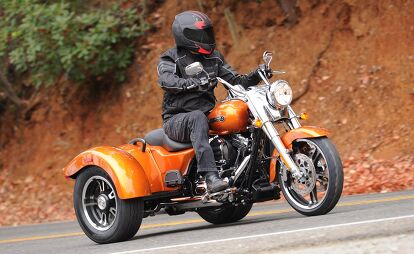








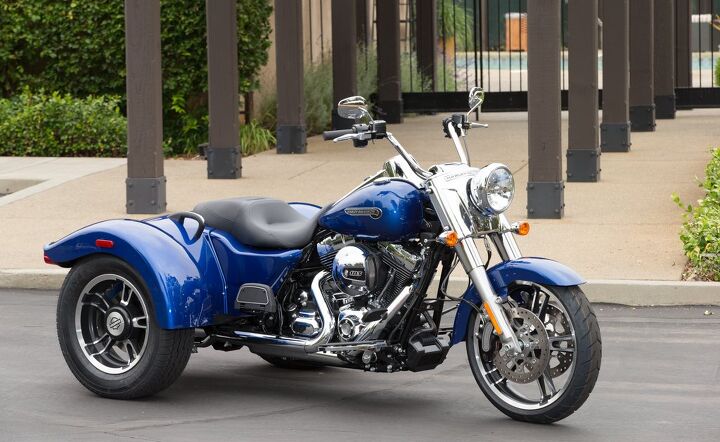











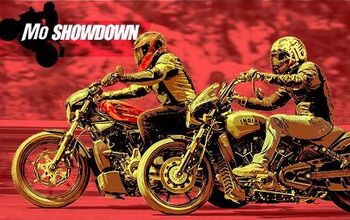
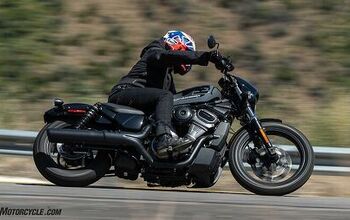
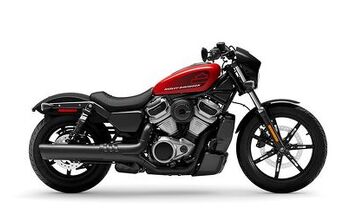
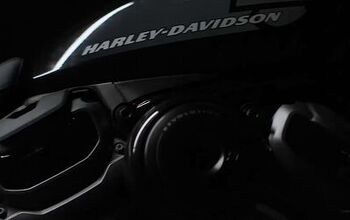
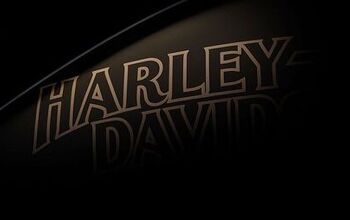












Comments
Join the conversation
I would like to agree with E8BIlLL like him I was GI Joe for many years and it has taken a toll on my body and yes I would much rather be riding on a RK than a trike but that what it is. 2012 i bought a TriGlide and put on 43000 fun full miles on it but i always felt somewhat like I was in a convertible cage and seeing how I never had a Glide I might have felted the same on them .So when I test rode a Freewheeler during bike week 2015 it didn't take much thought in trading the TriGlide in for a Freewheeler add a windshield, engine guard and a good seat Now I feel like i.m on a motorcycle again.
I have ridden for years, 2 year ago I had a brain bleed. My balance isn't what it use to be so I bought an 09 Ultra Classic Tri Glide and I love it. It's different than riding a 2 wheeler, you have to steer it plus it's hard to swerve around things. It gives you your freedom back!!!!!